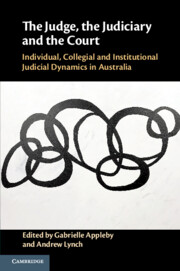 The Judge, the Judiciary and the Court
The Judge, the Judiciary and the Court from Part IV - Perceptions
Published online by Cambridge University Press: 04 May 2021
Despite the dominance of legal themes in popular culture, judges do not always make an appearance, and when they do, tend to be secondary and/or caricatures. Despite (or even because of) their relative absence and unimportance in popular culture, the portrayal of judges still gives insight into assumptions and values about the relationship of judges to the law and justice. This chapter explores two key themes in the portrayal of judges in the contemporary Australian television series such as Rake and Janet King and the classic Australian series SeaChange. The first is the portrayal of judges as marginal or secondary characters and the second is the desire expressed by characters for a ‘good judge’. Drawing upon the insights of the jurisprudence of American realists, this chapter interrogates the concept of a good judge in terms of authority, legitimacy and the relationship with law. How is the concept of the good (and of course the bad) constructed? There is also an interrelationship between the two themes: despite the desire for the good judge, the secondary role of judges in popular culture often reflects the tendency to regard the role of judges as primarily objective representatives of the institution of the court and law rather than as individuals.
To save this book to your Kindle, first ensure no-reply@cambridge.org is added to your Approved Personal Document E-mail List under your Personal Document Settings on the Manage Your Content and Devices page of your Amazon account. Then enter the ‘name’ part of your Kindle email address below. Find out more about saving to your Kindle.
Note you can select to save to either the @free.kindle.com or @kindle.com variations. ‘@free.kindle.com’ emails are free but can only be saved to your device when it is connected to wi-fi. ‘@kindle.com’ emails can be delivered even when you are not connected to wi-fi, but note that service fees apply.
Find out more about the Kindle Personal Document Service.
To save content items to your account, please confirm that you agree to abide by our usage policies. If this is the first time you use this feature, you will be asked to authorise Cambridge Core to connect with your account. Find out more about saving content to Dropbox.
To save content items to your account, please confirm that you agree to abide by our usage policies. If this is the first time you use this feature, you will be asked to authorise Cambridge Core to connect with your account. Find out more about saving content to Google Drive.